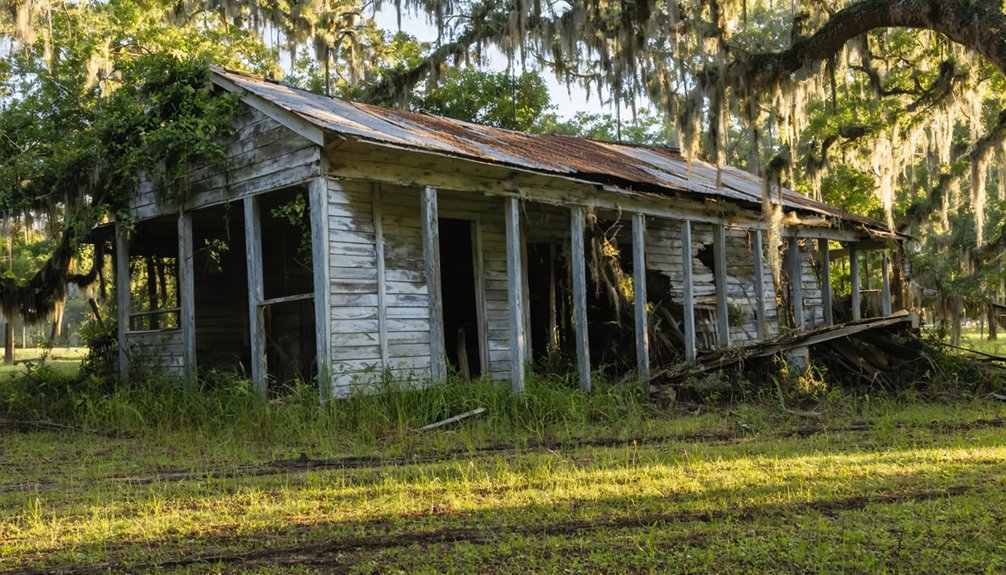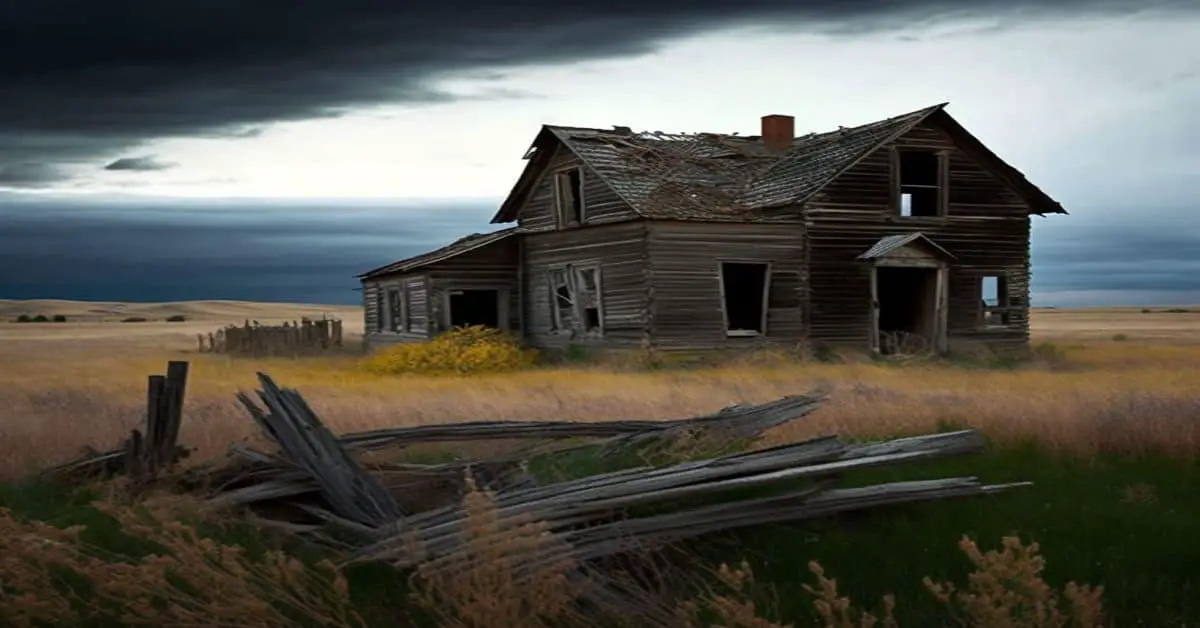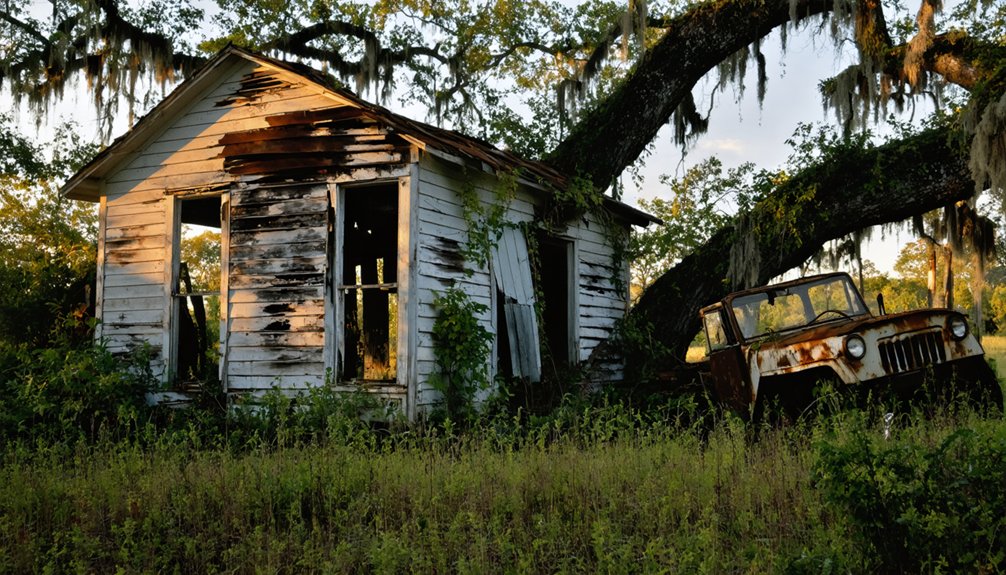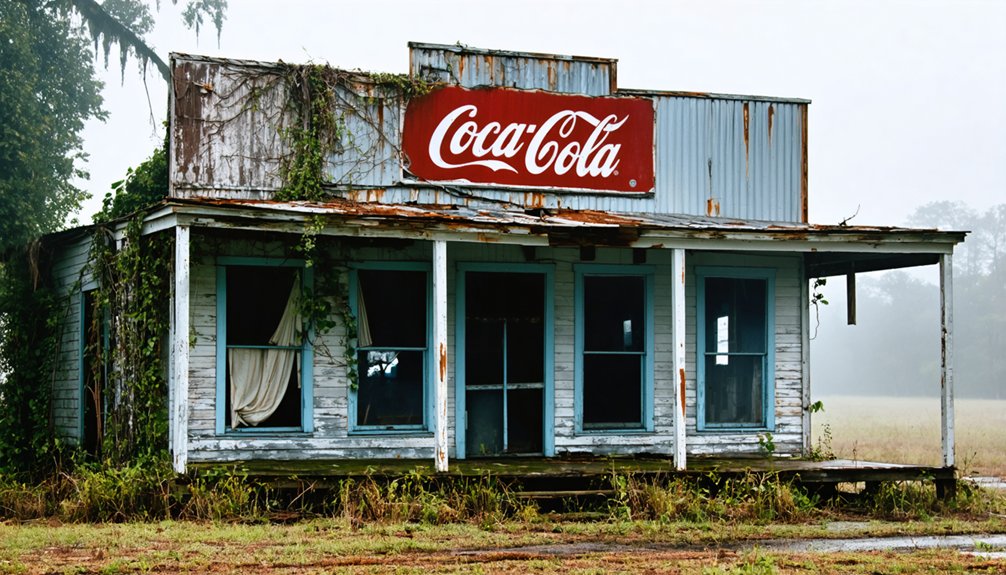You’ll find Ruddock’s haunting remains between Lake Pontchartrain and Lake Maurepas in Louisiana, where a once-thriving lumber town of 1,200 residents met its tragic end. Founded in 1892, this stilted settlement flourished until a catastrophic Category 4 hurricane struck in 1915, claiming 58 lives and destroying the community. Today, scattered concrete blocks and rotting timber peek through murky waters, while local legends whisper of Julia Brown, the voodoo priestess who foresaw the town’s doom.
Key Takeaways
- Ruddock was a prosperous Louisiana lumber town established in 1892, built entirely on stilts with wooden sidewalks above swampland.
- The town reached its peak population of 1,200 in the 1890s, featuring lumber mills, a locomotive repair shop, and a schoolhouse.
- A devastating Category 4 hurricane in 1915 destroyed the town, killing 58 residents and coinciding with Julia Brown’s prophetic death.
- After the 1915 hurricane, Ruddock was never rebuilt and became a ghost town, with structures slowly sinking into surrounding waters.
- Today, only scattered concrete blocks and submerged ruins remain between Lake Maurepas and Lake Pontchartrain, accessible by airboat tours.
The Rise of a Lumber Town
In 1892, the establishment of the Ruddock Cypress Company by William Burton and C. H. Ruddock transformed a quiet stretch of Louisiana swampland into a thriving lumber town.
You’ll find the lumber industry’s impact evident in every aspect of the purpose-built community, from the bustling sawmill to the railroad depot that connected residents to New Orleans.
The town’s strategic location between Lake Maurepas and Lake Pontchartrain proved invaluable, with workers digging the Ruddock Canal to transport cypress logs efficiently to the mill.
Nestled between two lakes, Ruddock’s strategic canal system revolutionized cypress logging in Louisiana’s challenging swampland terrain.
Community resilience showed early when the population swelled to 700 by 1910, as families settled into stilt-supported homes connected by wooden walkways.
The Holy Cross Catholic Church served as a spiritual center for the growing community of European immigrants.
The town’s infrastructure grew to include a locomotive repair shop, blacksmith, commissary, and one-room schoolhouse, creating a self-sufficient community in the Louisiana swamps. At its height in the 1890s, the town reached a population of 1,200 residents during the peak of lumber production.
Life on the Isthmus
Life on the isthmus between Lake Maurepas and Lake Pontchartrain demanded ingenuity from Ruddock’s residents.
You’d have found a community built entirely on stilts, with wooden sidewalks connecting homes and businesses above the swampy terrain. The unique isthmus ecology shaped daily life, as residents adapted to the hot, humid climate and ever-present water.
The 1915 hurricane destruction would later prove the vulnerability of this resourceful community. The railroad served as your lifeline in this remote wetland region, bringing supplies and connecting you to neighboring settlements like Frenier and Wagram.
Today, only an Interstate 55 exit marks where this once-vibrant town stood.
Community resilience showed in the way folks built their lives around the cypress lumber industry, creating a thriving town of nearly 900 people.
You’d have witnessed a bustling community of lumber workers and their families, all making their home in this challenging but resourceful settlement perched between the lakes.
The Fateful Storm of 1915
As you’d have witnessed it in September 1915, a Category 4 hurricane with 145 mph winds suddenly bore down on southeastern Louisiana’s coastal communities, giving residents little time to prepare.
The storm surge ripped through Ruddock with unprecedented force, destroying the rail station where many had sought shelter and forcing survivors to desperately cling to trees and floating debris. Many residents fled to safety by walking along the elevated railroad tracks to escape the rising waters. The storm coincided with the funeral of local resident Julia Brown, whose eerie song had predicted the town’s destruction.
You’ll find no trace of the original town today – the hurricane killed 58 Ruddock residents and so thoroughly devastated the settlement that it was never rebuilt, becoming one of Louisiana’s haunting ghost towns.
Storm’s Swift Approach
While residents of Ruddock went about their daily routines in September 1915, a weak tropical storm brewing in the Windward Islands would soon change their lives forever.
Without modern hurricane forecasting capabilities, you wouldn’t have known that this seemingly harmless disturbance would transform into one of the most powerful storms in U.S. history. As it moved westward across the Caribbean Sea, it intensified rapidly, reaching sustained winds of 145 mph. By late September, early radio communication helped track the storm’s movement, though warnings came too late for many communities.
By September 28, the monster storm curved northwest toward the Gulf of Mexico, setting its sights on southeastern Louisiana. The Weather Bureau quickly issued storm warnings for Louisiana as the hurricane approached the coast.
- The lack of storm preparedness and early warning systems left communities vulnerable
- The hurricane’s unprecedented 931 mbar pressure signaled catastrophic potential
- Limited transportation options trapped residents in harm’s way
Devastating Surge Strikes
Under the cover of darkness on September 29, 1915, a catastrophic 12-foot storm surge slammed into Ruddock’s vulnerable isthmus between Lakes Maurepas and Pontchartrain.
The Category 4 hurricane‘s 145-mph winds drove walls of water through the town’s wooden structures, which stood precariously on stilts above the wetlands. You’d have witnessed nature’s raw power as the flood impact devastated homes and businesses, leaving only one house standing in its wake.
The storm surge proved particularly destructive because the surrounding cypress forests, which once served as natural barriers, had been cleared for the lumber industry. The disaster occurred on the same day as the funeral of Julia Brown the Voodoo Priestess, whose dark predictions about the town’s fate had long haunted local residents.
Within hours, Ruddock’s stilt-supported sidewalks and buildings succumbed to the relentless waters. Fifty-eight townspeople lost their lives, while survivors were forced to wade through treacherous swamps seeking refuge.
Lives Forever Changed
The 1915 hurricane permanently altered both the physical and emotional landscape of Ruddock.
You’ll find that personal stories from survivors paint a haunting picture of loss – their once-thriving community reduced to silence and stillness overnight.
In the face of unimaginable devastation, survivors demonstrated remarkable community resilience as they trudged through swamps seeking help, knowing their hometown would never be the same.
- 58 residents lost their lives, leaving families scattered and forever changed
- Only one house remained standing, forcing the complete abandonment of Ruddock
- Survivors carried the trauma of losing their homes, neighbors, and way of life in a single night
Today, Ruddock exists only in memories and as an exit sign on Interstate 55, a stark reminder of nature’s awesome power.
Lost Beneath the Swamp
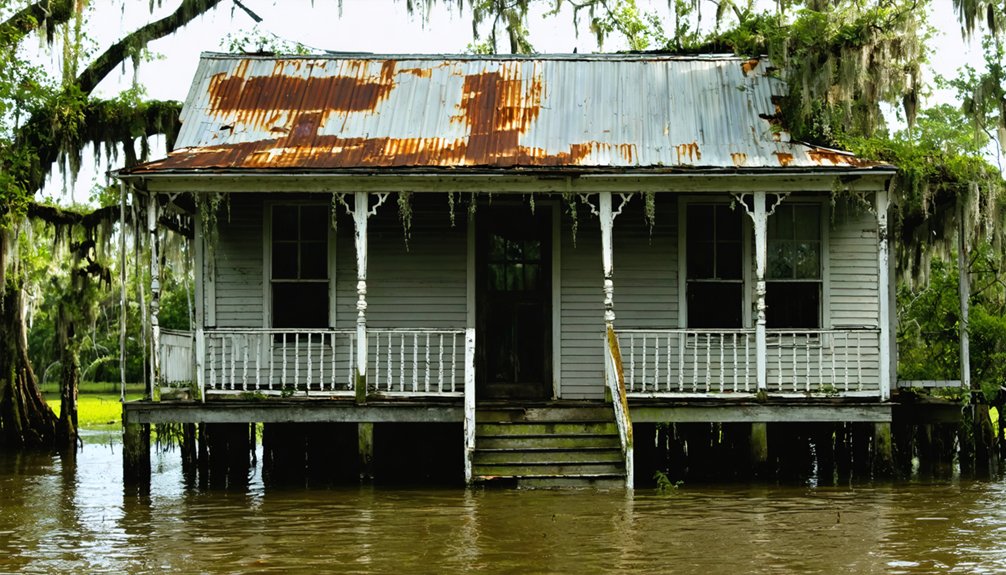
Since nature began its relentless advance, Ruddock’s remains have slowly disappeared beneath the murky waters between Lake Maurepas and Lake Pontchartrain.
Time and tide slowly erase Ruddock’s ghostly remnants, as murky waters claim what’s left between the great lakes.
You’ll find the ghost town’s remnants scattered throughout the swamp’s intertwining waterways, where concrete footings and weathered lumber peek through the dense vegetation.
If you venture through these waters today, you’ll glimpse traces of the town that once stood proudly on stilts.
The once-thriving settlement was home to busy lumber mills that powered the local economy.
The swamp reclamation has transformed Ruddock into an eerie landscape where moss-covered ruins lie partially submerged beneath the surface.
Only scattered artifacts in the Louisiana Treasures Museum and a few visible foundations remain to tell the story of this lost community.
Local airboat tours can take you through this haunting maze of waterways, where nature’s persistent force continues to consume what’s left of the town.
Legends and Local Lore
You’ll find Ruddock’s most enduring legend in Julia Brown, a voodoo priestess whose haunting prophecy allegedly foresaw the 1915 hurricane that destroyed the town.
The region’s folklore intertwines with tales of the Rougarou, a werewolf-like creature from Cajun tradition that’s said to stalk Catholics who break their Lenten promises through the surrounding swamps.
These supernatural elements have become deeply embedded in local culture, with tour guides and residents keeping the stories alive through firsthand accounts of mysterious encounters in the abandoned town’s watery remains.
Julia Brown’s Haunting Prophecy
Among Louisiana’s most enduring supernatural legends stands Julia Brown’s haunting prophecy, which became inexorably linked to the destruction of Frenier and Ruddock in 1915. Known locally as a voodoo priestess, you’ll find her haunting legacy deeply woven into the region’s folklore.
Her prophetic song, “One day I’m going to die and take the whole town with me,” echoed through the community before her death. On the day of her funeral, a devastating hurricane struck, destroying both towns and cementing her place in Louisiana’s mystical history.
- Brown’s role as a community healer and spiritual guide contradicts her portrayal as a malevolent figure.
- The storm’s timing sparked decades of debate about whether her words were a curse or a warning.
- Her story reflects the complex relationship between Louisiana’s voodoo traditions and local misunderstandings.
Rougarou Tales After Dark
When darkness descends over Louisiana’s misty swamps and bayous, tales of the Rougarou emerge from the shadows of Cajun folklore.
You’ll hear whispers of a fearsome shapeshifter standing seven to eight feet tall, prowling through the murky waters with a wolf’s head atop a human body. Local stories warn that if you’re bitten, you’ll carry the curse for 101 days – but don’t dare speak of your encounter for a year and a day, or you’ll transform into the beast yourself.
Throughout Acadiana, Rougarou sightings keep children close to home after sunset.
This legendary creature, evolved from French loup-garou tales, embodies the rich cultural fusion of French Catholic, Cajun, and Native American influences that define Louisiana’s mystical landscape.
Environmental Transformation
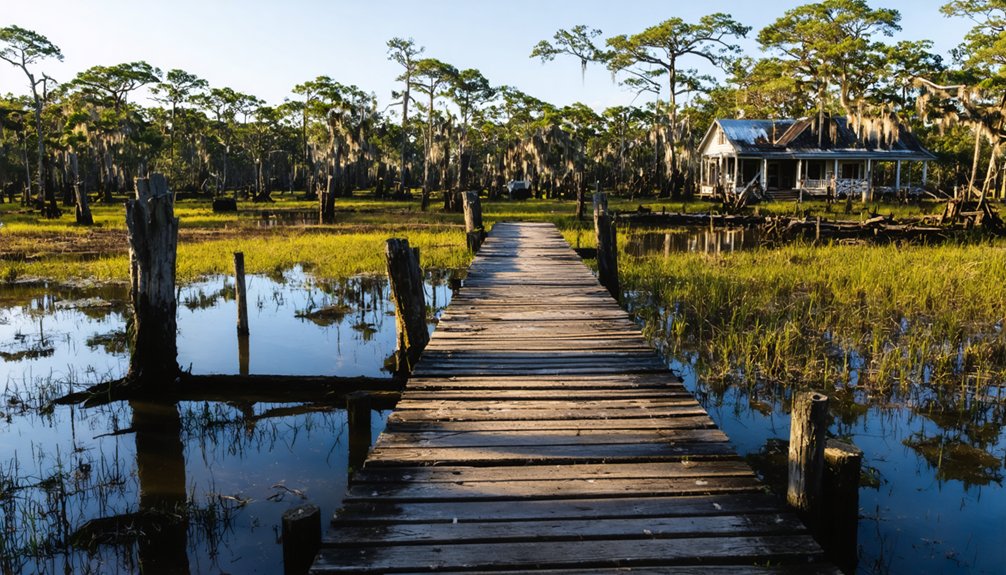
The devastating Category 4 hurricane of 1915 marked a critical turning point in Ruddock’s environmental transformation from thriving lumber town to swampland.
You’ll find that nature’s reclamation happened swiftly, as flooding between Lake Maurepas and Lake Pontchartrain accelerated the town’s decline.
The ecological resilience of the swamp environment proved unstoppable, with cypress trees and native wildlife gradually overtaking what humans had built.
- The swamp’s gradual encroachment transformed man-made structures into natural habitats, demonstrating nature’s power to heal and reclaim.
- Water from surrounding lakes and swamps reshaped the landscape, creating a new ecosystem where buildings once stood.
- Native vegetation and wildlife now thrive in the space where lumber mills and homes previously dominated, showcasing the region’s natural restoration.
Preserving the Memory
Numerous efforts preserve Ruddock’s legacy through historical documentation, oral traditions, and cultural representations.
You’ll find Ruddock’s memory alive at the Louisiana Treasures Museum, where artifacts tell the story of this once-thriving lumber town. The Southeastern Louisiana University’s research center maintains photographs and documents that chronicle the community’s daily life and tragic end in the 1915 hurricane.
Local storytellers keep Ruddock’s spirit vibrant through tales of Julia Brown’s alleged curse and the mysterious Rougarou.
You can explore this history through guided airboat tours, ghost stories, and Interstate 55’s haunting exit sign. Literary works like Tim Gautreaux’s “The Clearing” immortalize Ruddock’s essence, while documentaries and online resources guarantee this piece of Louisiana’s heritage endures for future generations.
Modern-Day Remnants
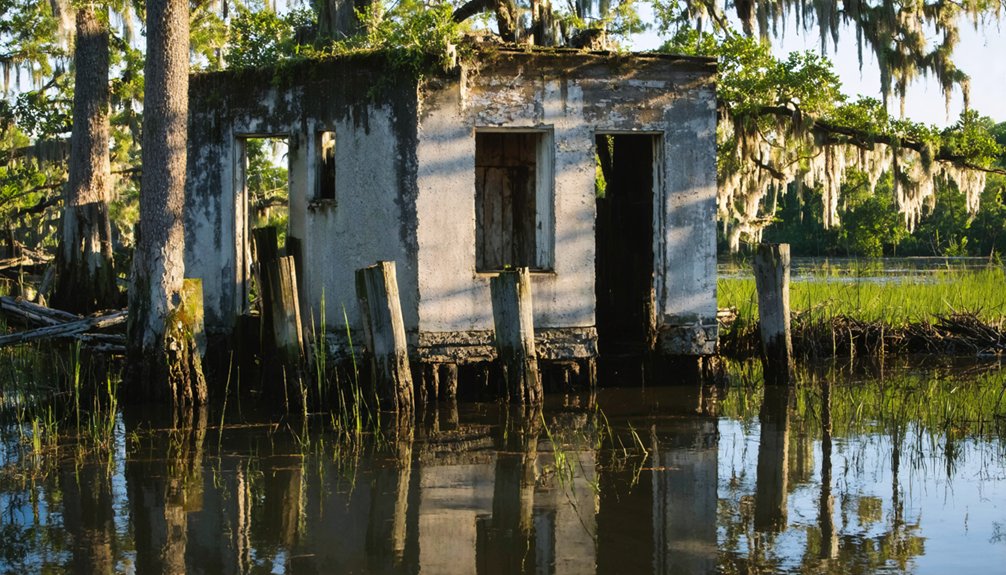
Today’s visitor to Ruddock encounters a haunting landscape where scattered concrete blocks and decaying pilings emerge from murky swamp waters.
You’ll find these abandoned structures mostly submerged between Lake Maurepas and Lake Pontchartrain, where cypress trees and dense vegetation have reclaimed what was once a thriving settlement.
The remote location, accessible only by boat or airboat, adds to the mystique that draws adventurous explorers seeking ghostly sightings and connections to the past.
- Wooden remnants of original buildings peek through the waters, marking where streets once stood
- Broken docks and tree stumps outline the former settlement’s boundaries
- Seasonal water fluctuations reveal different aspects of the ruins throughout the year
These weathered remains serve as silent witnesses to nature’s power to reclaim what humans leave behind.
Frequently Asked Questions
Are There Guided Tours Available to Visit the Remains of Ruddock?
You’ll find guided explorations by kayak or canoe from New Orleans, where naturalist guides share the historical significance while leading you through Manchac Swamp’s cypress channels to view Ruddock’s remains.
What Happened to the Survivors of the 1915 Hurricane?
You’ll find that most survivors relocated to LaPlace and Ponchatoula, where survivor stories tell of community resilience. They rebuilt their lives after clinging to trees and debris during the devastating storm.
Were Any Valuable Artifacts Recovered From the Submerged Town?
You’ll find many artifacts preserved at Louisiana Treasures Museum, recovered through underwater archaeology efforts. They’ve salvaged concrete footings, iron fencing, lumber pieces, and industrial remnants from the sawmill operation.
Can Visitors Legally Explore the Former Town Site Today?
You can’t legally explore the site since it’s a no-fly zone under private and protected swamp lands. Despite its historical significance, exploration regulations require explicit permission that’s rarely granted nowadays.
Did Any Businesses Attempt to Rebuild in Ruddock After 1915?
You’ll find Ruddock history shows no successful business revival after 1915. While some minor rebuilding attempts occurred into the 1920s, they failed to restore any meaningful commercial activity in the swamp-bound town.
References
- https://darktourists.com/ruddock-louisiana-entire-town-destroyed-by-hurricane/
- https://myfamilytravels.com/the-louisiana-ghost-town-where-halloween-feels-strangely-real/
- https://hnoc.org/publishing/first-draft/julia-brown-curse-hoodoo-hurricanes-and-storm-swamped-ruddock
- https://kids.kiddle.co/Ruddock
- https://www.youtube.com/watch?v=tbfJ5o6dd1E
- https://www.manchacgreenway.org/ruddock/
- https://lobservateur.com/2015/09/30/ruddock-washed-away-100-years-ago/
- https://www.crt.state.la.us/Assets/OCD/hp/nationalregister/historic_contexts/The_Louisiana_Lumber_Boom_c1880-1925.pdf
- https://www.manchacgreenway.org/8-rudock-canal-town-site/
- https://www.treasurenet.com/threads/ruddock-louisiana.232454/
